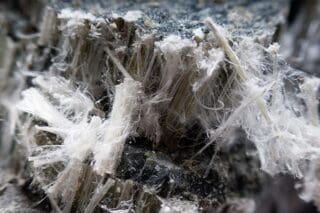As early as the 1890s, the link between asbestos inhalation and lung-related disease was established. What makes mesothelioma a particularly tragic disease is the fact that it’s preventable. The cause of mesothelioma is known. While oncologists and surgeons focus on how to treat mesothelioma, there are scientists who are primarily concerned with identifying the cause. Arthur Frank, MD, PhD, is one of those individuals.
Recently, Mesothelioma.com spoke with Dr. Frank, Professor of Public Health and Chair Emeritus of the Department of Environmental and Occupational Health at the Drexel University School of Public Health, about the international research on asbestos he’s championed since the early 1990s.
“The people who do treatment research are oncologists and radiotherapists and surgeons, so they’re not always as concerned with identifying what the cause was. That’s what I do. I identify the cause of things.”
His major research activities have included the study of occupational lung diseases such as asbestosis and silicosis, and occupational cancers, especially those related to asbestos exposure.
“Chance Favors the Prepared Mind”
While studying at the Mount Sinai School of Medicine, Dr. Frank met Dr. Irving Selikoff, a leading figure in asbestos research in the United States. Dr. Frank calls meeting Dr. Selikoff “serendipitous,” as Dr. Selikoff was doing a synthesis of many of the things Dr. Frank was interested in, from environmental exposures to cancer.
According to Dr. Frank, Dr. Selikoff did more than any other scientist to inform the general public about asbestos hazards, and expanded the range of individuals who would be at risk to include end users, not just miners, millers, and asbestos product manufacturers.
In college, Dr. Frank majored in anthropology and became interested in population and environmental exposures. Through Dr. Selikoff, Dr. Frank learned about workplace exposures. “I just got intrigued by this issue of asbestos causing disease, and here I am 48 or so years later still doing this work.”
An International Disaster: Surveying China and India
Asbestos disease is an international epidemic. Russia and Kazakhstan are two of the top asbestos-producing countries in the world, and while India now has a very small production of asbestos, India and China together make up 51% of the total asbestos use in the world. Dr. Frank’s research in these latter countries focuses on defining populations with asbestos-related disease.
The work Dr. Frank has done internationally extends back to 1991 when he studied health records of 1600 workers from three asbestos factories in China, one in Shenyang and two in Qingdao. In the United States, it is standard for individuals who work with asbestos to get yearly chest X-rays. In China, this was done much less regularly. Dr. Frank studied 1600 sets of X-rays of active workers and established a percentage who had underlying asbestos-related disease, such as asbestosis or pleural plaques, findings which were later published. In regards to those with mesothelioma, Dr. Frank pointed out the following: “In a working population, it is very unlikely that you’ll find lung cancer or mesothelioma. Those people are going to be too sick to be actively working.”
Subsequent to that, as China’s record-keeping processes progressed, Dr. Frank analyzed computerized records of all the cases of mesothelioma within an 8-year period in Qingdao. He found that patient ages ranged from teens to 90-year-olds. What was most unusual, however, was that the vast majority of mesothelioma cases were women. In the United States and Europe, the most common patient is male. “I’ve been monitoring this data every year since 2000,” he said, in order to understand why. “In Qingdao, more than half the factory workers were women,” he concluded. “It fits the pattern.”
In India, the government does not record cases of mesothelioma, and thus proclaims no one in the country develops the disease. But as Dr. Frank asserts, “a lack of data does not mean a lack of disease.” In fact, when speaking to a doctor from a major cancer hospital in Mumbai, Dr. Frank learned that, in just one year, there were 32 cases of mesothelioma in that hospital alone.
“A lot of the asbestos cement factories — a major use of asbestos in India — are owned by members of parliament,” he said. “You can draw your own conclusions.”
Now, Dr. Frank is performing similar research in Sri Lanka, where he is surveying X-rays of workers from asbestos cement factories, where construction materials like corrugated roofing are made — similar to the factories in China. Regarding the development of asbestosis, Dr. Frank tells us, “The preliminary data, which I’m not ready to make public, shows that they get the same range of disease as anyone else in the world.”
How to Make a Safer Future in the United States
When it comes to educating the public about asbestos and its current threat to public health, Dr. Frank says that we, the mesothelioma community, need “to educate people that asbestos is still around. It’s still a legal product in the United States. We need to make people realize that while we use it a lot less, it’s still out there.” As he further points out, in the past, roughly 25 million tons of asbestos was used in buildings and, in most cases, is still there. “It needs to be properly removed before putting people at risk.”
One of the biggest hurdles to putting an end to the asbestos disaster is the fact that, “people in the United States think that asbestos is a banned substance. It’s banned in over 50 counties, but it’s not banned here,” he says. Dr. Frank points to another concerning asbestos misconception: people believe there is something called “controlled use” of asbestos. “It’s a fiction of somebody’s imagination to think you can work with this stuff safely,” he says. Furthermore, asking if one type of asbestos is more or less harmful is, as Dr. Frank explains, “a legitimate scientific question. We don’t know the answer. But asking if one is more or less harmful is not the same as saying chrysotile is safe. It is harmful, and it may or may not be just as harmful.”
Ultimately, Dr. Frank believes the government’s lack of action will continue to devastate public health, and it’s more important than ever for organizations like Mesothelioma.com and the broader mesothelioma community to continue to spread awareness and education. “Until everyone makes sure they aren’t exposing people to asbestos, there’s going to be a tail of disease going out 50 years or more.”
Beyond spreading awareness to friends, family, and neighbors, Dr. Frank urges anyone who knows or suspects they’ve been exposed to asbestos to talk with their doctor about establishing routine testing, given the higher risk for developing certain kinds of cancer.





